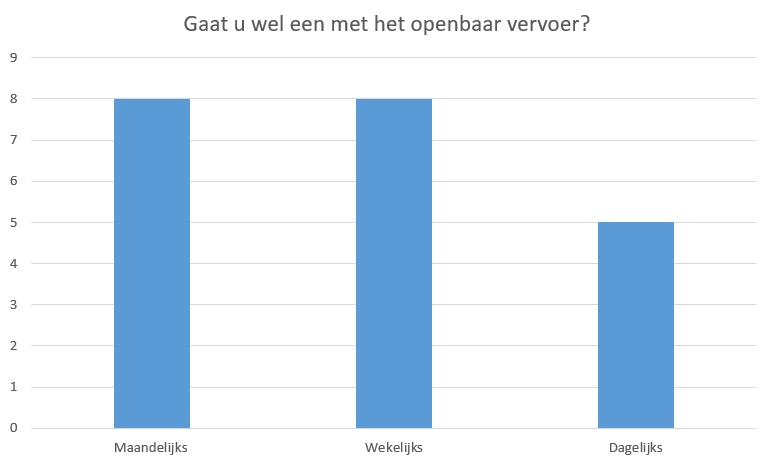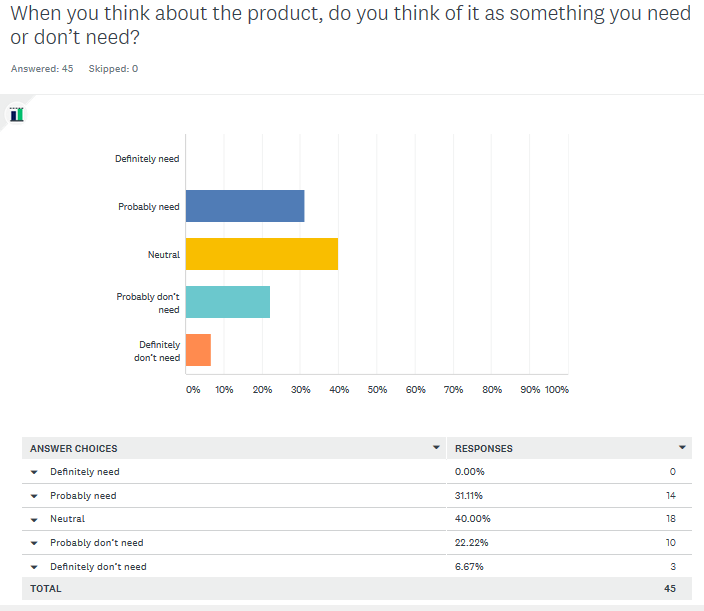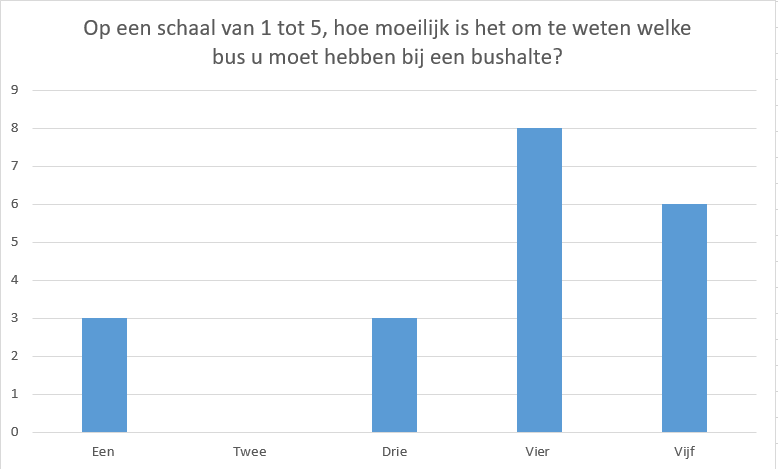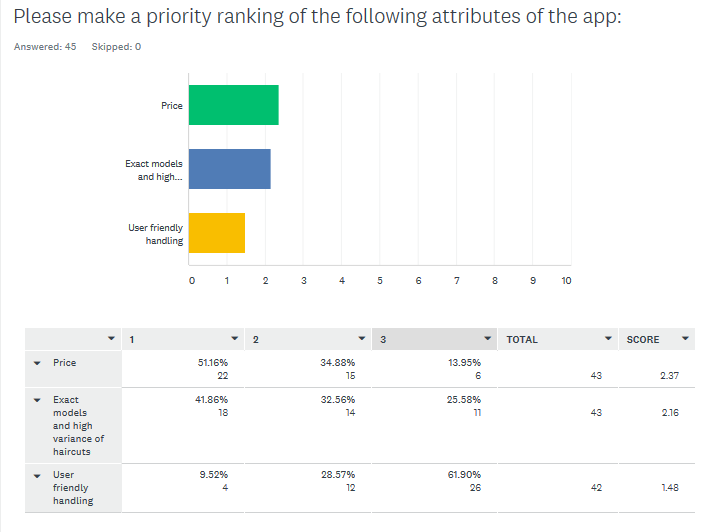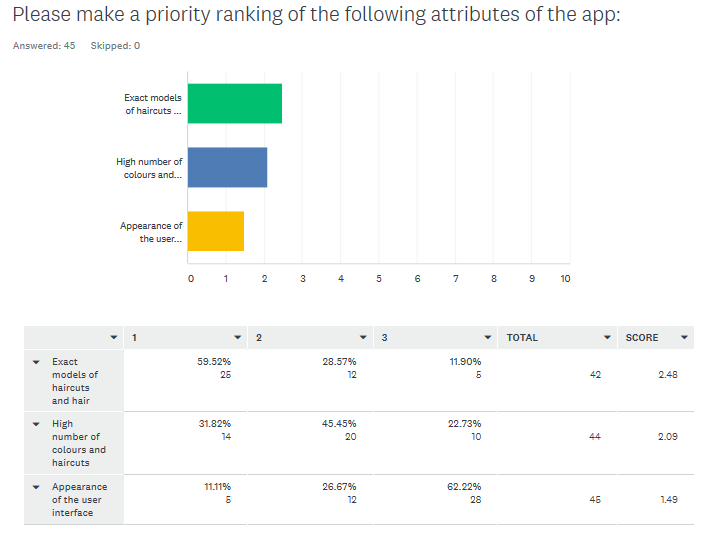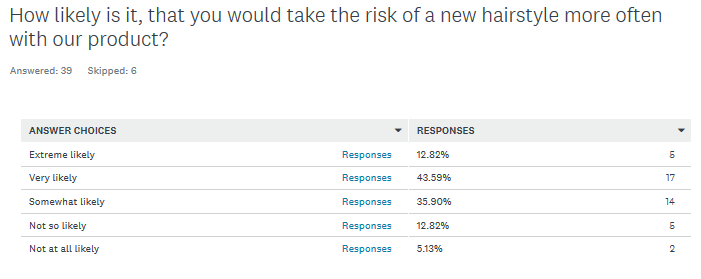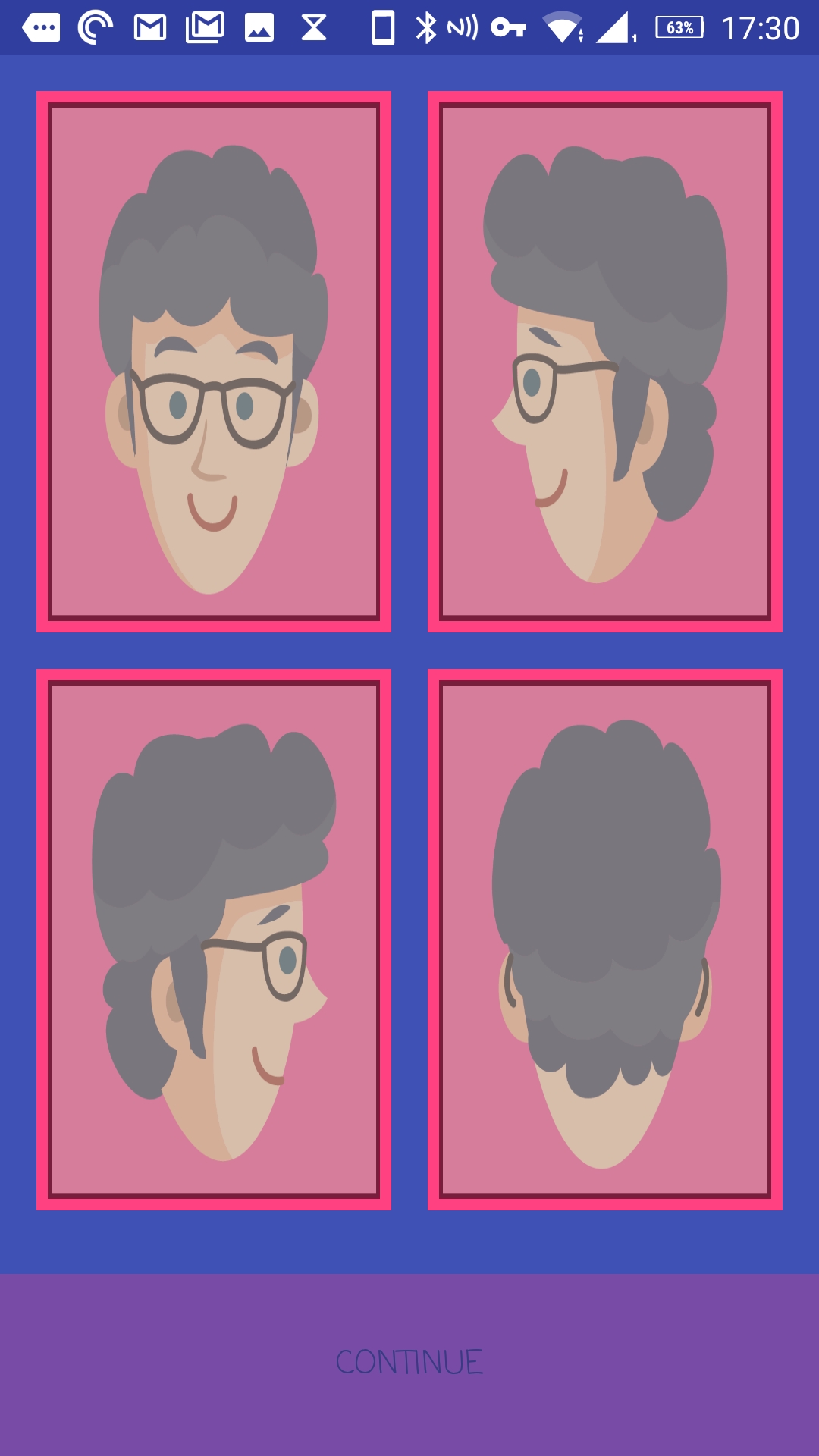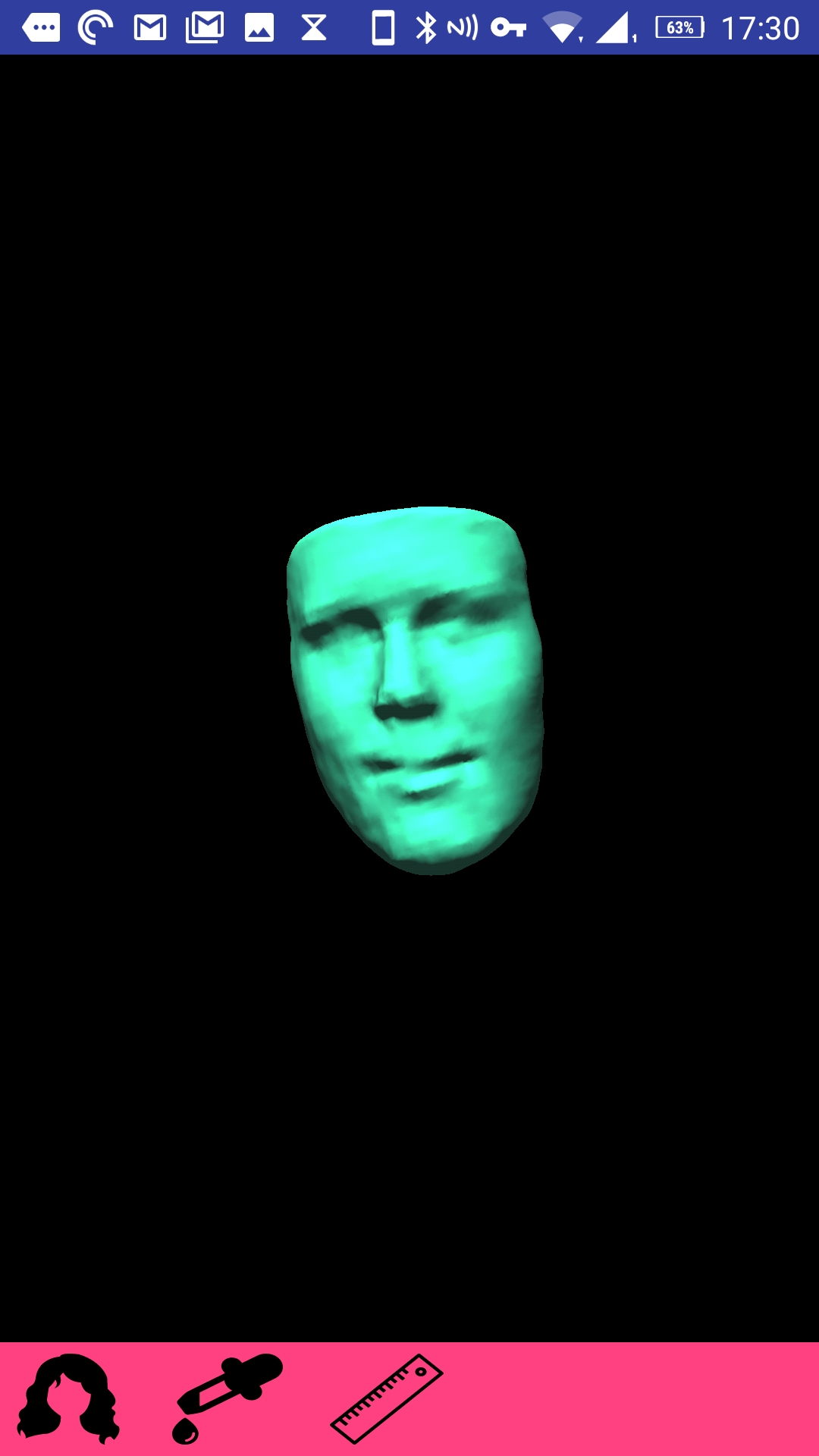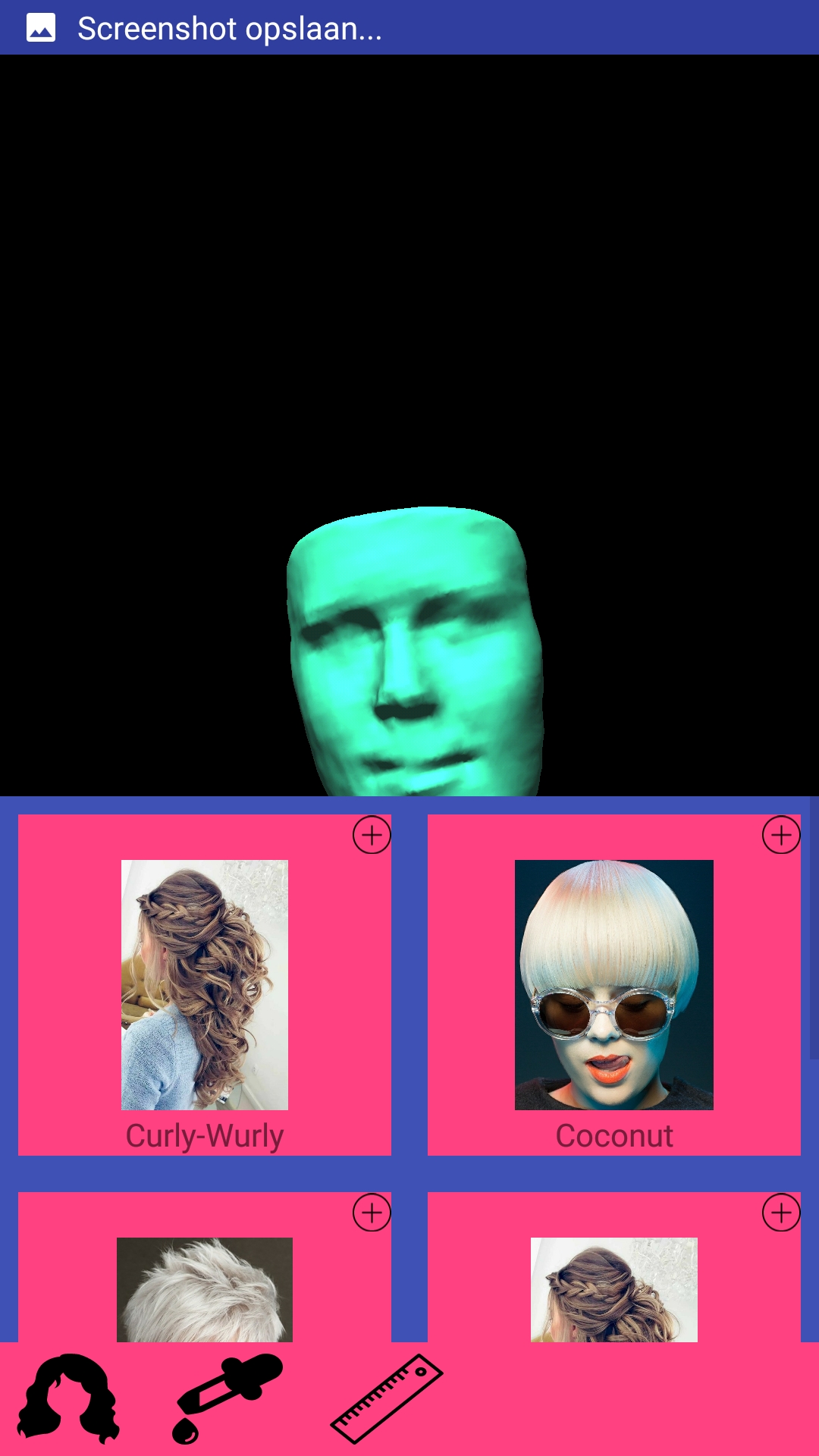Clairvoyance
To return to the home page click here.
To go to Coaching questions page click here.
Introduction and Description
Humans have been taking care of their hair since the Palaeolithic age, and nowadays hairstyles have become a staple in many different cultures and come in a variety of styles. In the western world, trends are usually established when celebrities appear in public with a new haircut, this often leads to a large number of people wanting a similar haircut. People rush to their hairdressers in demand for the exact same haircut not worried about the fact that it might look differently on them than it did on that celebrity. This can be due to various reasons like the difference in hair thickness, head shape or even lack of specific high-quality products and care needed to produce and maintain the haircuts. There is no real way to visualize the haircut on oneself apart from photoshopping images or using apps that give a poor representation. This is where Clairvoyance comes in.
There are multiple scenarios in which Clairvoyance can excel. Here are two of them.
Scenario 1
You walk into the hairdresser's with a haircut in mind, you explain it to your hairdresser and they seem to understand it. They start cutting and styling your hair only for you to realise at the end that this is not what you wanted. The haircut you received is not what you expected the haircut to look like on you, and that you've actually prefered another haircut. There is no way, however, to roll back to before you got the haircut and you are stuck with an unsatisfactory hair do. With this modern product, you will now be able to avoid all these unnecessary and annoying issues.
Scenario 2
You're a hairdresser and a customer walks into your store with an idea in mind. They present you that idea to the best of their ability, and you start cutting, styling and/or colouring their hair. When you present them with the final result they seem unsatisfied. This can be due to numerous reasons, you could simply have made a mistake, but most likely the haircut or style they requested is not what they expected it to be.
Description
The Clairvoyance preview imaging technology would allow for an easy bridge between a customer's expectation and a hairdresser's understanding! This can help them make a final decision on a haircut as well as concretise the idea customers have in mind. The product would allow for hairstyle and hair colour to be displayed and be easily customizable. No more miscommunications or disappointed customers.
Final Product
The final product will be an app. It will be able to create a 3D-model of a person’s head out of 4 pictures and adopt a 3D-haircut-model on it. It will recognize the age and sex of the person automatically and show proper haircut options. The user will be able to modify the hair length and colour manually. Furthermore he will have the opportunity to view different styling options for each cut. These options will include links to styling tutorials and an overview over the for the style needed products. After the choosing process, the customer will be able to share his haircut with friends on social media platforms, such as Facebook, Instagram, Twitter, Snapchat or Pinterest. If he wants, he can localize the closest hairdresser offering the requested haircut. He can take a look at pictures of previous results of this specific hairdresser and post a picture of his haircut after visiting him. In addition to that the customer can load his new haircut, used hair colours and hair regarding hair issues (such as thyroid or skin problems) in his personal profile on his phone. In that way his data will be protected on his own device and he is still able to show it to the next hairdresser.
An extended version of the app will be offered for hairdressers. It has all functions the private version has but allows the hairdresser to sign up a profile for his shop. The location of his shop will be saved there. In addition to that, he can upload sample pictures or videos of our predesigned haircuts on his customers. Users of the app will find his profile under each specific haircut and will be able to check him out before making an appointment. The hairdresser has also the option to build new haircuts and upload them with a tool we provide.
Existing Work
Research
Large Pose 3D Face Reconstruction from a Single Image via Direct Volumetric CNN Regression.[1]
State of the art AI technique for reconstructing facial meshes from a single picture. Does so by using a novel neural network technique called volumetric CNNs. For Clairvoyance this is a large piece of the puzzle since it would let us create realistic renderings of person's face with a different hairstyle. It is not the whole puzzle though; see the section drawbacks below. An online interactive demo of this technique is available at http://cvl-demos.cs.nott.ac.uk/vrn/
Head Reconstruction from Internet Photos.[2]
Reconstructs a whole head from hundredths of images. Results of the paper do not appear good enough for production.
3D Face Hallucination from a Single Depth Frame.[3]
Reconstructs a whole head from a single depth camera image. Impressive results.
Existing products
3D Reconstruction Products
Facegen[4]
Creates a 3D model of a person's head from a singular or multiple images. However, final results are not very personalized but instead are constructed from an existing database of the heads of many different people. The results seem more like avatars than realistic 3D models.
itseez3d[5]
Reconstructs any object in 3D by recording 360 degrees around an object with an iPad. Requires the Structure Sensor[6] third-party peripheral.
Challenges
See the existing work section first. We have found very little mention in literature or otherwise of automatically generating a 3D model of a person's whole head from a few images. Existing research seems not yet ready for production or requires a calibrated setup where the background is eliminated, lighting is constant and motion of the camera is controlled. There also exists work where relatively cheap depth cameras are used that provide impressive results, depth cameras are however not yet available on most mobile devices. However, there is promising work in reconstructing the face part of a head. It is possible to generalize the rest of a person's head. That is, "glue" the face part on top of an average head model. The drawback of this is that we lose important details (in the case of applying hairstyles) such as the shape of a person's ears.
Stakeholder
Primary Stakeholder
Primary Stakeholders are stakeholders using the system on a daily basis. In our case, they are hairdressers and private users. Both parties want all functions of the app to work properly. They want the user interface to look appealing and simple to use. The hairdressers want to attract more customers. First by the usage of the app, secondly by the personal advertisement profile they get. Furthermore, it makes it easier for them to spot their customer’s wishes. Private customers want to try out new styles and calculate the risk of a new haircut. They want to play with different styles. For each new haircut, they want to explore different styling options. In addition to that, they want to share their experience with friends or give their hairdresser a feedback. Their needs and the range of their needs will be specified more closely in the results of the user journey.
Secondary Stakeholder
Secondary stakeholders work with the system through an intermediary. They do not use it on a daily basis. In our case, secondary stakeholders would be people working on the app such as software engineers, our marketing team and the management. They all want adequate working conditions, a huge salary and satisfied customers.
The salary can be reached by optimising the costs and maximising the profit. Bonuses can be offered for hard-working collaborators.
The working conditions should orientate themselves on regulations of trade unions. Furthermore, the working atmosphere can be improved by taking stress from the employees. Daily childcare, team building workshops, a laundry service would be an option for a further developed company. In the beginning, the atmosphere could be enhanced by a Christmas party or active teambuilding.
Tertiary Stakeholder
Tertiary stakeholders are affected by the system or have an influence on the purchase. In our case, those stakeholders are society and the government. Society might or might not accept the app. Beauty blogger might have an influence on how the product sells itself. The government might restrict the development of the app through laws regarding privacy issues.
https://bizfluent.com/info-8353421-primary-secondary-tertiary-stakeholders.html
https://pdfs.semanticscholar.org/0172/aa9500b7801005d323a3f3dffbe90e46b03c.pdf
User Survey
To determine the customer value of the single functions of the product, we used a survey. It was send out to private customers and hairdressers. By letting them prioritise functions first on a superficial then on deeper levels, we could find out in detail which features are important for the customer. Based on the results of the study we build up our development strategie.
User Survey for private customers
45 students between 20 and 25 and from both sexes took part in our study.
Question 1
Question 2
Question 3
Question 4
Question 5
Question 6
Question 7
Question 8
Question 9
Question 10
Results
Market Value
We estimated the market value of the product based on 3 influences. The first one was how much a customer would pay for the app by himself, the second which amount of money could be reached by advertisements in the app. Last but not least we also took a look at how much money could be earned by selling personal data.
Comparable Apps
Most cosmetic simulation apps use a picture as basis and project make-up or haircut on this picture. The haircut is not well adjusted or looks artificial. In addition to that, it is only possible to see the haircut in the front of the face. For changing the hair colour those apps try to extract the hair from the picture and give it another colour. This method only works when the background and skin colour are very different to the customer's original hair colour. I cannot be applied to predesigned haircuts. Sometimes apps ask for the hair structure, but it does not have any consequences for predesigned haircuts. Our approach builds a 3D model of the head and applies the haircut on it. It fits the head and is turnable. Furthermore, hair colours and length can be changed for each model exactly. The model considers the structure of the customer's hair.
After choosing a haircut our app also gives ideas to style the hair including tutorials and needed products. Cosmetic apps are mostly free when the customer buys the app without special functions. Special functions can be for example trend information or a taller number of haircuts. We chose to offer the hairdresser version of the app for 10 Euro and the private customer version for free. Comparable apps have about 100,000 and 50 Million downloads. If we assume 10,000 downloads in first 6 months worldwide, 10% of the hairdressers. Furthermore, we expect 100,000 downloads after 2 years. That would be 10,000 Euro in the first 6 months and 100,000 Euro after 2 years.
Sponsored images
Instagram takes about 16 Euro for 1000 looks on a sponsored picture[7]. Assuming 10,000 users in the first 6 months we could take for each advertisement 1600 Euro in the first half year and 16,000 after 2 years. Assuming a range of 20 different products (e.g. gel, hairspray, salt water spray, hairdryer) that would mean 32,000 Euro after 6 months and 320,000 Euro after 2 years.
Data
The list of rights apps in the section has been long. Access to camera, media, location and WLAN has to be given to most styling apps. It is not said what this data is used for. Personal data could easily be sold via moving profiles, filming, audio data collection or analysing media on the advice. All of this is nothing we can accept responsibility for. The only thing we should evaluate is an anonymous statistics about most tried or shared hairstyles and sell it to fashion magazines or cosmetic companies. It would help them to identify new trends for the coming season and prepare a concept. For the development of our app, it could also lead to adjusting our haircut portfolio.
Laws and Ethics
Laws surrounding the issue
Independent Declaration of Human Rights
The idea of the mirror doesn’t violate any of the human rights since you voluntarily visit the hairdresser and can still decide to not have your hair cut after you dislike what you see. It is legal to put a price tag on the ‘’hair scanning’’ because it takes time and labour hours can legally be charged. The idea even really nicely complies with Article 27.
Everyone has the right freely to participate in the cultural life of the community, to enjoy the arts and to share in scientific advancement and its benefits.
As the concept of the mirror is very approachable for people from all classes, genders/cultures or religions, it is very easy to let everybody share in this scientific advancement and its benefits.
law
The Law: There are a couple of laws concerning the Privately-Identifiable Information and how that can be processed. Per 25 of Mei 2018 there will be a new law called ‘Algemeen verorderning gegevensbescherming’ (AVG). Before then the law ‘Wet bescherming persoonsgegevens’ (Wbp) must be followed. Before continuing with the law about personal information, we first need a clear understanding about what is personal information and what not. In general, ‘personal information’ means all the information about an identified or identifiable person natural person. This definition corelates with ‘personal data’ which means any information relating to an identified or identifiable individual (MvT, II, nr. 3, blz. 45). This means that the information must be about a person. Furthermore, the person must be identifiable or identified. If one if these to elements are not cleared, then we are not talking about personal information. Using this definition, the obvious things like, name, address and personal phone number are classified as personal information. However, when we ask for a username and password to make an account this doesn’t count as PII. https://autoriteitpersoonsgegevens.nl/nl/over-privacy/wetten/wbp-naslag/hoofdstuk-1-algemene-bepalingen-art-1-tm-5/artikel-1-sub-wbp https://www.clickinsight.ca/blog/usernames-privately-identifiable-information
The law Wbp is based on the European guideline for privacy protection that was made in 1995 24 October. The law had been in force since 2001 1 September. The law states that the following can happen with the personal information: • Personal information can only be used in things that do not break the law. • Personal information can only be used for activities that have been determined clearly before the obtaining the information. • The owner of the information must know the organisation or person that is using the personal information. • The personal information must be protected, for special personal information there are more strict laws. Every organisation that uses personal information must report this to ‘Autoriteit Persoonsgegevens’. https://autoriteitpersoonsgegevens.nl/nl/onderwerpen/avg-nieuwe-europese-privacywetgeving/mag-u-persoonsgegevens-verwerken#hoe-weet-u-of-u-persoonsgegevens-mag-verwerken-6310 There is a time to bridge before the AVG goes into effect. In this time organisation can prepare themselves so that they have to abide to the new law. The AVG does bring changes with it. One of the main changes is that it will be a law that all EU countries have to abide to.
This means that for example, Facebook is a organisation that collects PII, name address etc, in different countries. At the moment they are allowed to do different things with PII in different countries while in others it will not be allowed. When the AVG is in effect this will change so that all countries have the same rules and protocols. The reason is that all the laws in the countries concerning PII is because they are based on the EU guideline but are interpreted differently. Furthermore the effect of this law is that people have more influence what happens to their information. In the AVG it is stated the owner of the information has to give permission to the organisation so that the can use the information for what they want to process it. The Organisation has to be able to prove that the owner of the information has given his or her permission. Furthermore it has to be as easy to retract given permission as it is to give permission. Additionally there are some new rights that people will have concerning their PII. Right to forgetfulness. This law states that people have to right to tell an organisation that they have to remove all the information that they have on them. When somebody has told an organisation that they have to remove their information, also other organisations that have gotten the information through the organisation in question have to remove the information. Right to data portability This law states that people have the right (tied to some conditions) to receive all the information that a organistion has in a standartformat. This is so that people can quickly change from one provider to the other by themselves. They could even ask the old provider to send their information to the new provider if this is technically possible. https://autoriteitpersoonsgegevens.nl/nl/onderwerpen/avg-nieuwe-europese-privacywetgeving/algemene-informatie-avg
Privacy
Privacy is a fundamental human right recognized in the UN Declaration of Human Rights, the International Covenant on Civil and Political Rights and in many other international and regional treaties.
In the Netherlands, a business must follow the Dutch Data Protection Act (Wet bescherming persoonsgegevens, Wbp). This act outlines and emphasizes the amount of care needed when handling a customer's personal data. Without such acts, the data would be vulnerable to criminal activity such as theft. Transparency, with the user, about the usage of the data is crucial, they should be informed of where and how their data is being used. In some cases, the data must be reported to the Dutch Data Protection Authority, DPA (Autoriteit Persoonsgegevens). In addition, the customer should be made aware of your details such as your address and company names as well as making sure they are informed when you intend to share their data with other companies. It is furthermore, mandatory to include a privacy statement on your website if you have one.
A model that can be used when dealing with privacy factors in multimedia information sharing context is what we will refer to here as the Adams' privacy model. The aim of this model is to help multimedia communication systems to "determine which information users regard as private, from whom, and in which context". Rather than dealing with privacy as a black/white (or binary yes/no) variable, the model attempts to define "privacy boundaries" which if breached will reduce the effectiveness of the system being used. Furthermore, what defines these boundaries is, in fact, the privacy "perception" of the users. According to Adams' model, the User is anyone who has their data transmitted either directly or indirectly. Direct information may, for instance, be a person's consumption habits or medical records, while indirect information might be their image or voice. In fact, the user may not actually be actively using the system and may be totally unaware that their data is being transmitted. As shown in the figure below, Adams' model defines three main factors which interact with one another to create the users' overall perception of their privacy. These factors are defined as:
- Information Sensitivity: is the primary privacy factor which the other factors affect to determine the perceived sensitivity level. Information Sensitivity in a way defines the users' perceptions of the confidentiality of the information being transmitted. Also, users' judgment of the sensitivity levels of the information is not binary (private/not private), but multi-dimensional with varying degrees of sensitivity.
- Information Receiver: is the users' perception of the person who receives and/or manipulates their information. Although a range of factors would influence the users' assessment of the Information Receiver, the issue of trust seems to be the most important one in defining the users' perception of the Information Receiver.
- Information Usage: is the users' perception of how and for what purpose their information will be used at present as well as in the future. The potential importance that the users attribute to the perceived Information Usage is crucial to the users' estimation of privacy risk/benefit trade-offs.
A model that can be used when dealing with privacy factors in multimedia information sharing context is what we will refer to here as the Adams' privacy model. The aim of this model is to help multimedia communication systems to "determine which information users regard as private, from whom, and in which context". Rather than dealing with privacy as a black/white (or binary yes/no) variable, the model attempts to define "privacy boundaries" which if breached will reduce the effectiveness of the system being used. Furthermore, what defines these boundaries is, in fact, the privacy "perception" of the users. According to Adams´ model, the User is anyone who has their data transmitted either directly or indirectly. Direct information may, for instance, be a person's consumption habits or medical records, while indirect information might be their image or voice. In fact, the user may not actually be actively using the system and may be totally unaware that their data is being transmitted. As shown in the figure below, Adams´ model defines three main factors which interact with one another to create the users´ overall perception of their privacy. These factors are defined as:
- Information Sensitivity: is the primary privacy factor which the other factors affect to determine the perceived sensitivity level. Information Sensitivity in a way defines the users' perceptions of the confidentiality of the information being transmitted. Also, users' judgment of the sensitivity levels of the information is not binary (private/not private), but multi-dimensional with varying degrees of sensitivity.
- Information Receiver: is the users' perception of the person who receives and/or manipulates their information. Although a range of factors would influence the users' assessment of the Information Receiver, the issue of trust seems to be the most important one in defining the users´ perception of the Information Receiver.
- Information Usage: is the users' perception of how and for what purpose their information will be used at present as well as in the future. The potential importance that the users attribute to the perceived Information Usage is crucial to the users´ estimation of privacy risk/benefit trade-offs.
Posting pictures of clients
Using pictures that you've taken exclusively for the business' Facebook page is the safest option. Since you own the photos, you don't have to get permission from anyone else before using them, unless the images contain customers or employees. In those cases, simply ask the people in the photo to give you written permission to use the image. This can be in the form of an informal email or a consent form that you prepare and ask them to sign. This protects you from anyone coming back later to say that they're upset or angry that you've included them on Facebook without their permission.
Image Content
Facebook prevents businesses and personal users from uploading images of an extremely graphic nature, especially if those images contain nudity. While Facebook does not prevent you from doing so, you might also want to watch out for posting pictures of children. Anyone under the age of 18 cannot legally consent to being included in your Facebook page, so veer away from posting their photos unless you get permission from their parents or legal guardians.
Marketing Strategy
Social Media Concept
We decided to focus our marketing on social media. The reasons are obvious: Advertisement there is effective and cheap. Furthermore, it approaches exactly our target audience. People tending to use “new media” are also more likely to download an app. Especially apps such as Snapchat, Instagram or Pinterest focussing on pictures and the looks are very likely to be used by our audience.
To create our marketing as effective as possible, we created a concept for our brand including some basic social media rules:
Target audience
It is important to make target audience specific advertisement. Not every platform addresses its audience in the same way. Facebook users are for example 50-60 years in average, whereas users of Instagram, Snapchat, Pinterest and Twitter are mainly between 15 and 35 years old.[8]
Follower base
The more follower of the brand has, the more likely it is to be seen by a lot of people. In order to get a follower, it is important to first build a solid base. This can be done by adding all friends and friends of friends.
After that, it is important to find so-called “multiplier”. Those are people attracting many others and can be used to advertise our brand. Influencers or bloggers are examples of multipliers. We can make offers to beauty bloggers to link their channel in the styling tutorials in our app in exchange for being named in their videos or being connected to their accounts. We can comment and like what they do, in exchange for them liking and commenting our product. In social media, it is all about interaction. The technique here would be linking influencer with a high reachability in our tutorials and comment and like at channels of the more unknown ones, who are still thankful for every follower.
Connection
The user should feel emotionally connected to the brand. It is important to face users on a personal level and make the brand more human. That can be reached by providing insights in the personal life of the people behind the app. For example, the social media account of the brand can be given to one person of the team and let him or her post every day. First about what they do for developing the product, but secondly about their daily life. Hairdresser and influencer should also get the opportunity to take over the account for a month.
In addition to that, it is eligible to put some user stories online. Users are given a voice. They feel part of a community, in which they are welcome and appreciated. The same community influencer they adore is part of. Those stories can be for instance their experiences with the app or previous hair styling faux pas. Users also can be asked about their opinion of new predefined haircuts or styles.
To deepen the connection between users and brand influencer can be used even more intense. They already have the connection to users. A haircut called after the influencer or an influencer’s face as example model are ways to connect the brand to the user unconsciously to his reputation. Furthermore, links of well-known beauty bloggers can be listed in our styling tips. In exchange for this advertisement, influencer might use our app for their videos or pictures.
Pictures
- The profile picture in every app should be the logo of the brand.
- The title picture on Facebook should be a pic of a group of people using the app together. Positions should be open and the user should feel as a part of the group. In this way, he feels connected and welcome.
- The highest reachability on pictures will be reached if pictures touch their audience emotionally.
Nostalgic pictures arouse nice and warm feelings. People will feel connected to their childhood and to the brand the same moment. It will generate trust. We can post a picture of a girl getting her hair done by her mother. Historic hairstyles (from the 20th, 40th, 70th, 90th) would also work. To increase the effect we can use pictures of idols people had in their childhood. At this point, it is necessary to keep attention to the user’s age in each social media.
Being funny is also a way to attract people’s attention. It causes sympathy and good feelings, which immediately connect with the brand. It is also a good way to get connect the brand and the user. Laughing about the same things causes bondings. In our concrete situation, we could let users post pictures of their failed haircuts in the past. We could also take pictures of animals instead of people and project the haircut model on them.
Hashtags
Hashtags are a way to tag or find posts on social media. The widest scope is reachable with eleven hashtags. We need a scientific and personal hashtag for our product, in our case we choose #clairvoyance. In addition to that is is always good to stick with trendy hashtags. A weekly overview you can find at this link: http://hashtagify.me/popular
Requirements, Preferences and Constraints
Requirements
- The application allows the user to take pictures and form a picture set.
- A picture set consists of 4 pictures, capturing the front, back, left and right side of the user's head.
- The application has to be able to create a 3D model of the user's head out of a picture set.
- The application is able to extract the specific side of the user's head from each picture in the picture set.
- The application has to be able to apply a 3D model of a haircut on the head of the 3D model of the person’s head.
- The user should be able to manually choose and change the applied hairstyle.
- The application must be able to show the results of applying a 3D model of a hairstyle on the head of the 3D model of the person’s head (3D view).
- The user is able to pan the 3D view by swiping left and right; thereby allowing the user to see the whole of his generated head and applied hairstyle.
Preferences
- The product should offer a well-received user experience (as determined by user tests).
- The product should offer a tutorial in which the user is told how to use the product.
- The application will initially contain at least 3 hairstyles per gender (male and female).
- The application will allow changing the colour of the hairstyles.
- The application will be able to download and use new hairstyles from a central server hosting our hairstyle files.
- The hairdresser can pre-select which hairstyles he/she is able to cut/style.
- The hairdresser can pre-select which hairstyles can actually be cut/styled for the current client.
- The application will provide a realistic lighting solution for the 3D view.
- The user is able to select different lighting.
- The user is able to select light colour.
- The user is able to select light position.
- The user is able to select light intensity.
Constraints
- The application must run in iOS 10 devices.
- The application must run suitably (as determined by user tests) on a fifth-generation iPad or later iPads.
- The application must run on Android 8 devices.
- The application must run suitably (as determined by user tests) on a Samsung Galaxy Tab S3.
- The application must run suitably (as determined by user tests) on an Asus ZenPad 3S 10.
Prototype
The prototype will consist of an Android app, showcasing our vision in terms of user experience and functionality. Its primary purpose is to gauge interest in the final product to potential buyers and users.
Requirements
The prototype will have:
- User interface to take 4 pictures of the user.
- A 3D view showing a 3D mesh of a head.
- At least 2 different hairstyles. The exact number will depend on the time required to create (or download and use) a single hairstyle (TBD).
- User interface to select different hairstyles.
- The 3D view shows the selected hairstyle on top of the user's head.
- The 3D view is rotatable so that user can see his whole head with the selected hairstyle.
The prototype will not have:
- The ability to convert from picture to 3D mesh. Instead, we will pre-generate a 3D mesh.
- The ability to dynamically add the hair to the 3D mesh. Instead, we will pre-generate this.
- A realistic lighting solution. Instead, we will use a simpler lightning solution.
Implementation
The app is created in Android Studio using the programming language Kotlin and Java. Functionality such as taking pictures, showing a 3D view and selecting hair styles and hair colors are successfully implemented. The user interface has been designed in accordance with Android's standards for user interface design (Material Design). Furthermore, the 3D view is purposefully designed to be similar to SnapChat's interface for editing photos. Designing an user interface to be similar to existing and familiar user interfaces helps the user quickly understand our app without being explicitly told what to do.
Discussion
In this section, we will focus on the what we were not able to do during this project, as well as areas where increased research and experimentation is needed.
Technical features
Since what we have as our final product for this course is a prototype, we don't have a fully functioning product. This prototype doesn't provide some important technical features such as the following.
High-quality resolution of the hair:
The current resolution of the hair is simply what Maya has to offer and while this is useful for a prototype, customers will request more accurate and realistic hair in order to improve the immersion of the application.
Hair type:
Although trends and culture can cause hairstyles to be similar within communities, there are many hair types that need to be taken into account. From straight hair to afros, hair varies in curliness, in fact, many people choose to go from one hair type to another. The current application does not take this into account due to the number of hairstyles made in the limited amount of time. This is an important feature because people sometimes enjoy straightening or curling their hair for a change and therefore seeing the possible drastic result is crucial.
Hair length is another factor that should not be ignored, although people can't instantly grow their hair at the hairdresser, people let their hair grow different amounts based on preference and sometimes people decide to go for drastic changes.
The thickness and the amount of hair on are variables affected by genes, age, and even stress. Many hairstyles require a certain degree of these variables in order to hold or even just to look similar. This is obviously an essential part of the final product.
Accurate hair movement and physics when rotating the face:
Since hair is made up of hundreds of thousands of thin hair strands, its individual as well general position can be changed by just a small breeze. Because we live actively and constantly move our heads and bodies around, our hair is subjected to this movement and moves depending on its length and the force issued onto it. In order to improve the realism of the application hair movement can be added such that people can visualize how their hair would move around and relate more easily to the displayed 3D image.
Hair reflectivity from various light sources:
Although this is a minor adjustment, it might be interesting to add different settings in which the hair is illuminated by different light sources and light types.
Accurate real-time customizability such as:
- Hair length customization
- Hair type (thickness or curls)
- Hair colour
Hair customizability is a crucial feature in this application because its the primary component that facilitates the interaction between the hairdresser and their customer. Furthermore, it allows for more creative freedom as well as quick visualization of the expected final product. Although our prototype already fulfils some of these features, it does so in a limited fashion and thus doesn't represent the full potential of these features.
App developments
Furthermore, some developments could be made to the app itself in regards to:
Data transfer from one app to the other:
It might be interesting to a customer or hairdresser to be able to share haircuts they would like to have or have been customizing or working on. This would either be possible by sharing it on social media and messaging apps or through the app itself if both parties have the app. Not only would that boost the popularity of the app without advertising, it would also make people more likely to download the app and try it out themselves.
Server storage of data for personal use application:
The prototype does not have a way to store personal information but this would be part of the final product. In this way, users will have a history of their haircuts that can be shared with any hairdresser and possibly any of their friends. This, however, requires backend services as well as a thorough understanding of privacy which has been expanded on in this wiki.
UI improvements to make the app look better:
The current interface is simple and effective, but by no means is it optimal in terms of aesthetic and design. This can be achieved by hiring a good frontend designer or by relying on user feedback to improve it.
Ratings in terms of difficulty for the desired hairstyle to be realised:
If the haircut you desire is quite complex to get right it might be more effective to go to a higher end hairdresser. By adding a rating both the customer and the hairdresser are aware of the risk they are going to take. This is a good selling point for more experienced hairdressers and could boost the competitiveness of the hairdressing sector.
Social Network
Additionally, it would be interesting to create a social network for the users which allows them to
- Share haircuts they have created using the app
- Rate and comment on other haircuts
- Rate and comment on hairdressers
- Save haircuts to a favourites tab to see how it would look on them
Using a social network, we can create a community for the application which would popularise its use and enhance the content of the app itself through community submissions.

